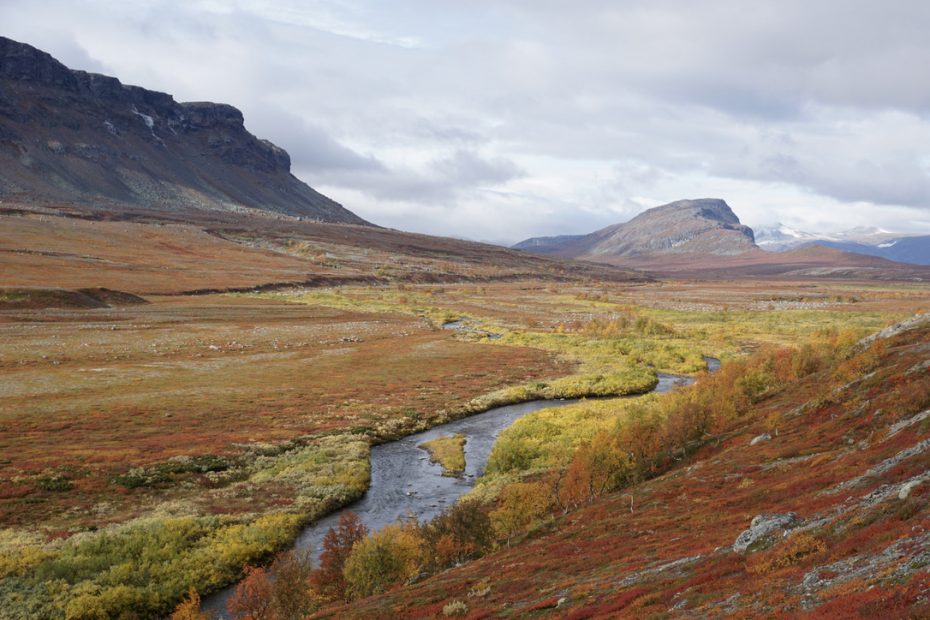Kungsleden is an awesome hiking trail located in the very north of Sweden, within the Arctic Circle. I hiked it in September and absolutely fell in love with it. If I was about to hike this trail again, I would still go in September, and here’s why.
Why I loved hiking Kungsleden in September:
No mosquitos
Kungsleden is known for ferocious bloodthirsty mosquitos, that are super active in summer. Some hikers go as far as recommending mosquito nets, especially when hiking in July. In September there was no problem with them, autumn is not their jam.
Autumn colors
While I cannot say how Kungsleden looks in summer, in autumn I was mesmerized even when hiking in the forest. The colors are so strong and vibrant - all those yellows, reds, and greens! The mountains were also decorated with the first snow, adding to the charm.
Northern Lights
There are more chances to spot Northern Lights in September. Some of my fellow hikers saw them a few times, while I spotted them (my first time too!) on my last evening in Abisko.
Quiet mountain huts
Kungsleden in general is not as busy as e.g. Tour du Mont Blanc. However, the fjällstugas tend to get very busy during the summer. I don’t mind people, but in the dorm-style rooms there’s always someone snoring, so I tend to sleep badly in the mountain huts. This was not the case in September as I usually had a full dorm room to myself. One time I even had the whole fjällstuga for me only.
Quiet popular sections
I had a similar experience on the section between Singi and Abisko, which other hikers describe as “the highway of Kungsleden”. It was the very closure of the season when I hiked there and I met only a couple of people, no big groups. I didn’t feel any extra stream of people compared to other sections.
While I highly recommend September as Kungsleden hiking month, there are a few things that are specific to this month. I didn’t consider them as deal-breakers, but I wish I knew about them before the trip to prepare myself a bit better.
Swedish mountain huts (fjällstugas) have a clear summer season when they are open. I did Kungsleden from 11th to 20th of September, while the summer season ended on the 18th of September. Even if you are not planning to stay in the fjällstugas, the closure date can impact your trip plans since fjällstugas provide boat services and have the only food stores in the area.
What to keep in mind when hiking Kungsleden in September:
Fewer motorboats and busses
In September some of the motorboats and busses adjust their schedules and operate less frequently, so you should double-check if the schedule you’re looking at is valid for September as well. E.g. in Teusajaure, the boat operates three times a day in high-season (07:00, 16:00, and 18:00) while in September it only operates twice (07:00 and 16:00). The same goes for the bus between Saltoluokta and Vakkotavare, as it operates only once a day in September.
These adjustments can be a bit challenging if you’re tight on time. You might get delays, especially if there is no other alternative. To avoid this unnecessary stress, I would suggest researching all the schedules before the trip while specifically checking September schedules.
Tip. Most of the guidebooks are written for summer/high-season hikers, so double-check the schedules they provide.
Resupplying food might be tricky
At the end of the season, the fjällstugas rarely get any extra supplies. As I was hiking on the week of closure, most of the stores were almost empty. Even the large fjällstations such as Saltoluokta had very little supplies to offer, e.g. no cookies or chocolate, no sausages, no bread, only some heavy cans of sausages or corn.
I was glad that I took most of the food from home, but I really had to ration it as the chances of buying more were slim. Next time I would take more food to make sure I don’t depend on the supplies on the trail.
Summer season closure
As mentioned above, fjällstugas are open until a specific date. As the wardens of fjällstugas are usually the ones operating the motorboats for mandatory lake crossings, those services are no longer available after the closure date. The same goes for rowing boats, they are also removed when the season ends, so you need to make sure that you cross all the lakes before the closure date. The closure of fjällstugas also means the closure of food stores.
The good news is that if you want to camp next to a fjällstuga, after the closure it’ll be completely free. However, the only facility still open will be a toilet, the rest of the buildings will be closed.
Cold nights
I completely underestimated the weather in September. Some of the days were still sunny and beautiful, while the nights were cold. On some nights I had below zero temperatures, my tent was even a bit frozen during my last camping night. I knew it might be cold, but did not expect that cold.
My advice would be to pack four-season gear, even though it’s early autumn for the rest of Europe. It is much colder up in the north.
Kungsleden is an amazing trail that left a great impression on me and it’s well worth visiting it in September. Now that you know what to keep in mind, nothing is stopping you from hiking it too.
If you still have any questions or you need my advice, leave a comment below or contact me via a contact form. Happy trails!


